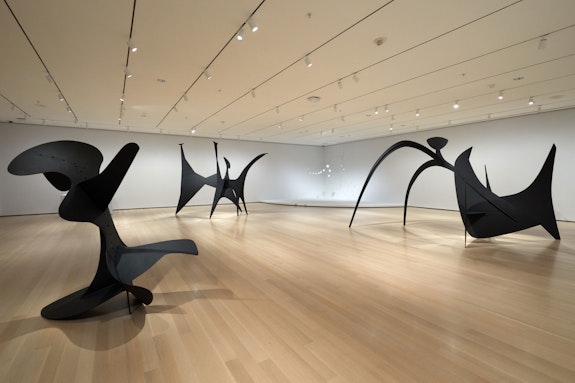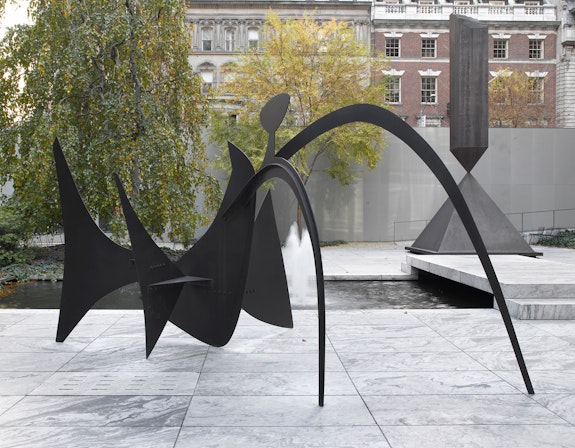ArtSeen
Alexander Calder: Modern from the Start

On View
Museum of Modern ArtModern from the Start
March 14 – August 7, 2021
New York
In a published interview (with Carter Ratcliff in 1988), Louise Bourgeois told on three “charmers” working the Museum Modern of Art, each of them a favored artist of the trustees: Mark Rothko, Ben Shahn, and Alexander Calder. Hard to picture Rothko the fawning courtier, but we do know that nobody didn’t love Sandy Calder.
The Museum considers Modern from the Start the story of a relationship to its first and only “house artist,” but the exhibition cannot answer the question Bourgeois’s tale leaves begging: just how did this artist and institution hit it off so mightily? We would love to observe the careerist in action, but that story could only play out in a novel, or an exhaustive biography, which hasn’t happened yet.
The exhibition is two big rooms, connected by a passage. Not a career retrospective, but it is a lot of stuff: mobiles, stabiles, maquettes, various flatworks in many mediums, wall works, jewelry, two pieces in the garden, and the Lobster Trap and Fish Tail (1939) in the stairwell, just outside. The first room is dominated by two stabiles, the very first of them all, Black Beast (1940), and a high-period classic, Black Widow (1959). Stabiles alone would have made many another artist’s career, but Calder had in effect several. Seeing these stabiles with Snow Flurry I (1948), an as-classic mobile, one might note that the stabile is a special case of the mobile: same vocabulary, sans only wire, plus only stove bolts. Both planar, with the same touch-and-go relationship to support and gravity, but the stabiles bristle with a menace that is often vanishing but never entirely disappears from the fully airborne works. Many a creature of reason has a mean streak somewhere. Our good man Calder had an emotional spectrum a good deal longer and spikier than his reputation entails.
The passage is littered with the peripatetic works in wire that Calder could stuff into suitcases and travel with from New York to Paris, and back. Also, quite delicate motorized works, tottering between an age-appropriate quaintness (they’re nearly 100 years old) and their original, nervy DIY impudence. One hopes they can be powered up, intermittently, once more. Excepting the machines, these early works are all likenesses, and as frequently animals as people. Like Brancusi, Calder was a lifelong animalier, whose gift for human likeness and character was equaled by only the very best of portrait sculptors. Young Calder could walk into a space with a roll of wire and make a show on the spot; these wire busts were a staple of his walk-on performances. The exhibited Portrait of a Man (ca. 1928) is subject-unknown: apparently Calder couldn’t quite remember just who the guy was.

After bumping into abstraction, Calder eschewed mimesis entirely, saying “… of course if it meant anything it would be easier to understand, but it would not be worthwhile.” Emptiness was then something to be attained to, but if absence were his intention, it couldn’t stick. His work, down to the last cut and folded ashtray, is imagistic. His fairground portrait artist’s knack for likeness inflects every mobile’s least obviously depictive petal. Snow Flurry I is hardly “abstract”—we know perfectly well every mobile, every stabile is alive. The artist was an animist to his fingertips. His funny electricity zigzags between intended nothingness and I-can’t-help-myself animal presence.
The last room, more various and miscellaneous than ever, contains relatively few pieces in motion and more non-planar work in all three filled-out dimensions. Cutting flat shapes in sheet metal, Calder was alone with himself and somewhat apart from history, but he carved and modeled occasionally throughout his practice. Many elements of the circus are adroitly whittled, and some sheet metal forms are quite delicately modelled—with a hammer. Under wartime reduced access to metals, he made a number of “Constellations” of carved and painted wooden elements, interspaced by straight wire and hung rather high on the wall. The titles suggest something astronomical, and the artist muttered something about certain cosmic gases, but the things seem to have retreated to the high wall from the floor, on their feet.
Constellation with Red Object (1943), a standby of the permanent collection, is braced here by two loans from the Calder Foundation, Black Constellation and Wall Constellation with Row of Objects (both 1943). The exhibition may not answer some of its own questions, but these three pieces stake one that Clement Greenberg posited in the ’40s. He acknowledged Calder’s multifarious talents and noted the light felicities of his work, but was that enough? Calder had evidently borrowed from Miró everything but the air. The “Constellations” are composed of something like little Brancusi, Giacometti, Arp, and Miró-esque game pieces, plus astral space: would that be merely good taste?

Question fair, premise correct, answer unaccountably short-sighted. Calder had no equal in poetic practice. None of his creditors was more neatly allusive, muscular in compression, ruthless in brevity, or incisive in their precision. But however industrious a fashioner of things, Calder was, true, also rather lazy in development. Donald Judd, otherwise admiring, noted just that in reviews. Calder took his time. But went places. Judd complained of an early iteration of Mountains and Clouds (1976). The monumental version, a late work now occupying the atrium of the Hart Senate Office Building in D.C., is literally titanic. No equal, anywhere. Pushing the nine-story skylight above, it is continental America, and it stands up to the Government.
Unwilling to dwell with the latent emotions visible in his own work, Calder mostly excused himself from them, under what he took for an inherent privilege of abstraction. He substituted ineffable humor for visible subject, brilliantly, as James Johnson Sweeney noted back in the ’40s (no one has written better on Calder since). As a consequence, he collected his carefree popular appeal, but was burdened with chronic underweightness. It could so easily have been otherwise, but he simply didn’t care to confess. “That others grasp what I have in mind seems unessential, at least as long as they have something else in theirs.”
Calder is justly beloved for his unpretentiousness, but there is an aethereal condescension somewhere high in that egalitarian voice. Lightness, indeed. I know who I am. First lord of the air.
The mobiles did not leave the ground quietly; they rend intellectual territory. Tearing it audibly, with something like the predatory scream of a jet engine. Calder was no imperialist, but the mobiles were an exercise of raw power that cleared the ground beneath them to blasted tarmac. He swept away “sentiment,” as Sweeney said, and razed the plain for the Minimalists to come. But the stabiles arrived first. Bestowed by the sovereign, saturnine, solitary, and silent bard of his own new-found land.

